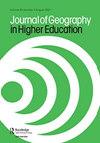地理空间技术在灾害研究和应对中的应用——Paper2GIS在国际实地课程中的案例研究
IF 1.8
4区 教育学
Q2 EDUCATION & EDUCATIONAL RESEARCH
引用次数: 0
摘要
摘要地理空间技术革新了灾害研究和地理课程,为决策分析和可视化地理空间数据提供了强大的工具。本文介绍了Paper2GIS的一个案例研究,这是一个在东冰岛Seyðisfjörður进行的国际实地课程中测试的现场数据收集应用程序。实地课程的目的是让学生了解跨学科地理空间技术在灾害研究中的实际应用。学生体验了使用Paper2GIS进行地质/自然地理野外制图和数据收集。结果表明,Paper2GIS在促进具有参与性成分的灾害研究以及简化地理实地课程数据收集方面的有效性。Paper2GIS被证明是一个有效的工具,可以加强协作、数据可视化和决策。研究结果为希望将低技术地理空间技术纳入其工作的研究人员、从业人员和教育工作者提供了有价值的见解。关键词:参与式制图参与式地理信息系统数字鸿沟野外工作自然灾害致谢作者感谢极光联盟对野外课程的财政支持。Aurora已经获得了欧盟地平线2020研究和创新计划的资助,资助协议号为101035804。披露声明作者未报告潜在的利益冲突。有关实地课程的进一步信息,请参阅https://geovis.hi.is/teaching/courses/geospatial-technologies-fieldcourse/。通过https://geovis.hi.is/teaching/storymaps-showcase/aurora-field-course-20222可以访问以StoryMaps形式提供的学生活动报告。奥罗拉大学联盟是一个由九所欧洲大学组成的网络。参见https://aurora-universities.eu/本文章由计算机程序翻译,如有差异,请以英文原文为准。
Geospatial technologies in hazard research and response – a case study of Paper2GIS in an international field course
ABSTRACTGeospatial technologies have revolutionised the field of hazard research as well as geography field-courses, providing powerful tools to analyse and visualise geospatial data for decision-making purposes. This paper presents a case study of Paper2GIS, an application for field data collection tested during an international field course in Seyðisfjörður, East Iceland. The field course was designed to expose students to the practical application of interdisciplinary geospatial technologies in hazard research. Students experienced geological/physical geography field mapping as well as data collection using Paper2GIS. The results demonstrate the effectiveness of Paper2GIS in facilitating hazard research with a participatory component, as well as the simplification of data collection during geography field courses. Paper2GIS proved to be an effective tool for enhancing collaboration, data visualisation, and decision-making. The findings provide valuable insights for researchers, practitioners, and educators looking to incorporate low-tech geospatial technologies into their work.KEYWORDS: participatory mappingparticipatory GISdigital dividesfieldworknatural hazards AcknowledgementThe authors would like to thank the Aurora Alliance for the financial support of the field-course. Aurora has received funding from the European Union´s Horizon 2020 research and innovation programme under grant agreement No 101035804.Disclosure statementNo potential conflict of interest was reported by the author(s).Notes1. For further information about the field course see https://geovis.hi.is/teaching/courses/geospatial-technologies-fieldcourse/. Student reports in the form of StoryMaps about their activities can be accessed through https://geovis.hi.is/teaching/storymaps-showcase/aurora-field-course-20222. The Aurora University Alliance is a network of nine European universities. See https://aurora-universities.eu/
求助全文
通过发布文献求助,成功后即可免费获取论文全文。
去求助
来源期刊

Journal of Geography in Higher Education
Multiple-
CiteScore
5.80
自引率
9.50%
发文量
29
期刊介绍:
The Journal of Geography in Higher Education ( JGHE) was founded upon the conviction that the development of learning and teaching was vitally important to higher education. It is committed to promote, enhance and share geography learning and teaching in all institutions of higher education throughout the world, and provides a forum for geographers and others, regardless of their specialisms, to discuss common educational interests, to present the results of educational research, and to advocate new ideas.
 求助内容:
求助内容: 应助结果提醒方式:
应助结果提醒方式:


